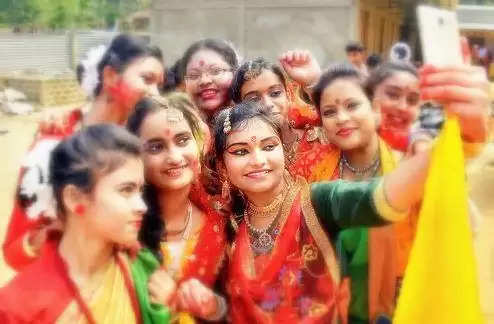Holi Celebration in Tripura- Then and Now!

AGARTALA: Holi is to spread different colours of gulal everywhere and painting people's face with colours wishing them 'Happy Holi.' But the way of celebrating this festival of colours in Tripura's royal period was a bit different.
The colourful festival was not only meant to play with colours but a reason to celebrate brotherhood. The festival was popularly started in the era of King Birchandra Manikya between 1862 and 1896. Holi used to be celebrated in the royal palace for seven days.
"Holi was then a reason to strengthen the existing bond between us irrespective of caste, creed or religion. And the Holi used to be celebrated for a week. Different blend of colours were mixed in a tank full of water that was used for the celebration. After Manipur, Tripura was the second Northeast Indian state to celebrate Holi in a grandeur way that time," said Dhruva Deb Burman also known as Dhruva Karta who is related to the Manikya dynasty.

Later, Maharaja Bir Bikram Kishore Manikya Deb Burman, son of King Birchandra Manikya's grandchild – Maharaja Birendra Kishore Manikya Deb Burman also continued the trend of the festival. However, he had invented an interesting way of concluding the festival after seven days of its completion.
During his period, he invited all relatives and people having proximity to the Manikya family through horse-carriages to play with colours on the occasion of Holi in the palace. The Holi festival was later followed by 'Holi songs' by at least 8-9 different troupes and a grand feast in all these seven days. On the eighth day, the King chose one person as 'Holi Raja' for the day and then he was made to mount on a horse backward to ride till Howrah River followed by music bands. There, the 'Holi Raja' was given 'fake visarjan' (immersion) in the river to end the week long festival.
Recalling those days, Dhruva Karta, who is now 80-year-old, said that the fake visarjan was an implication of ending the Holi festival. After that the 'Holi Raja' was awarded. That 'Holi Raja' concept ended with Bir Bikram's demise.
"I was lucky to witness this trend of Holi festival in Bir Bikram's era where I used to play Esraj, a musical instrument during Holi song in the palace. I was then studying in class four or five in Umakanta School which has now turned into a Higher Secondary School. Those days were really colourful," he said.
He further said, "Maharaja Birchandra Manikya and Bir Bikram even participated in the Holi song. Maharaja Bir Bikram had sung many Holi songs." However, Bir Bikram's wife – Maharani Kanchanprabha Devi had also organized such grand Holi festival twice.
The festival was postponed due to unforeseen events somewhere between 1949/1950 but it was resumed again in 1959 with the intervention of Kanchanprabha Devi's daughter-in-law –Maharani Padmabati, he said.
In recent times, a pyre made of bamboo and bushes would be lit after sunset inside the Ujjayanta palace on the eve of Holi, i.e, on Sunday signifying Holika Dahan. The ritual symbolizes victory of good over evil. The next day, people would play Holi.

A festival of colours, Holi is an event that marks the victory of good over evil. Lets make it a point to celebrate this victory of the good noy just one day for all the other days to come.
–By Priyanka Deb Burman for TNT-The Northeast Today
priyankadb27@gmail.com

















